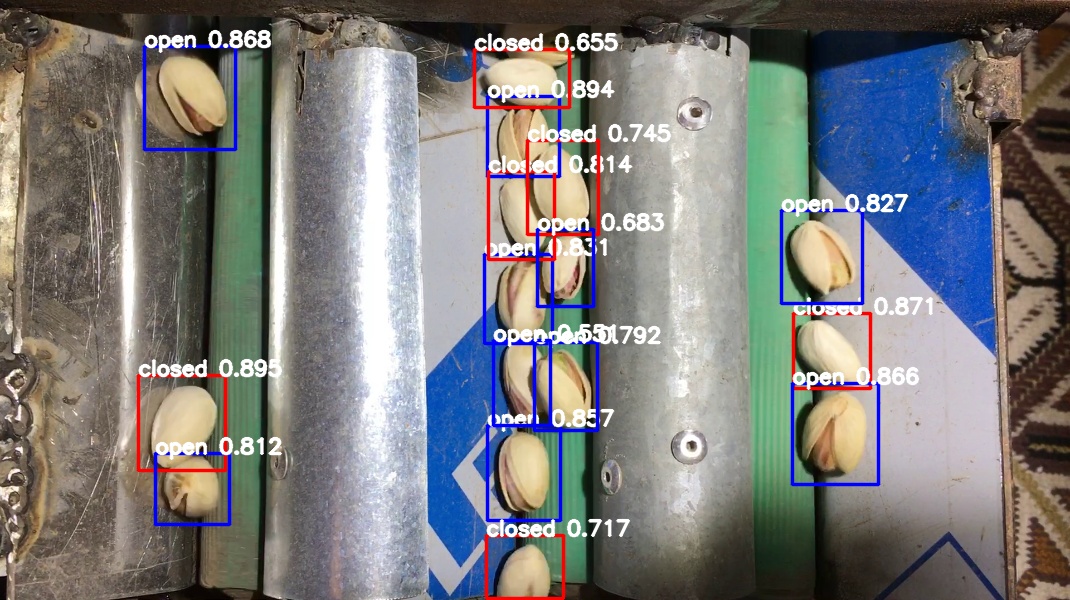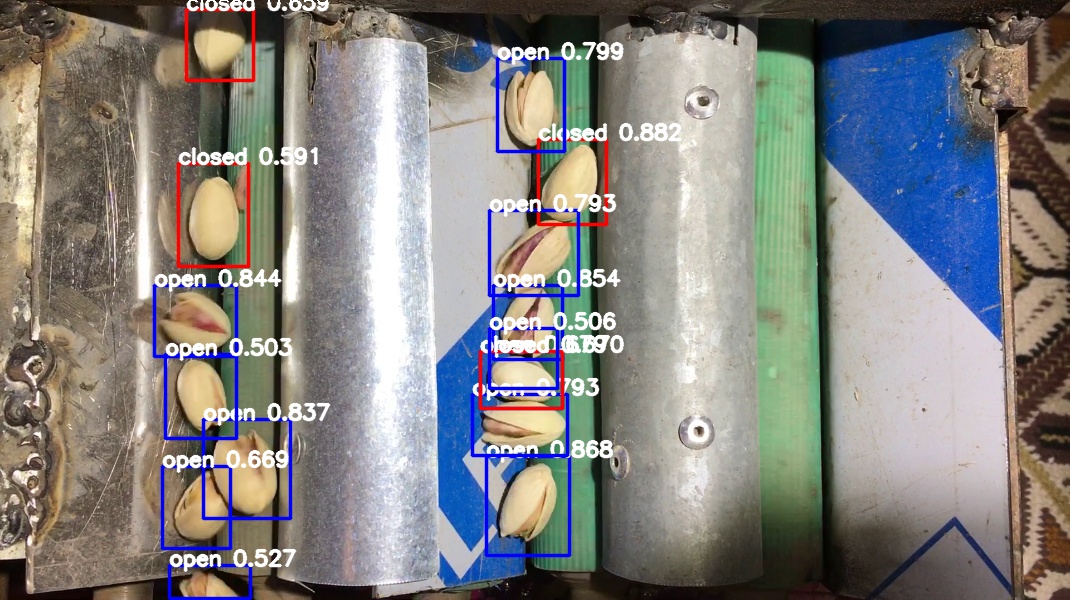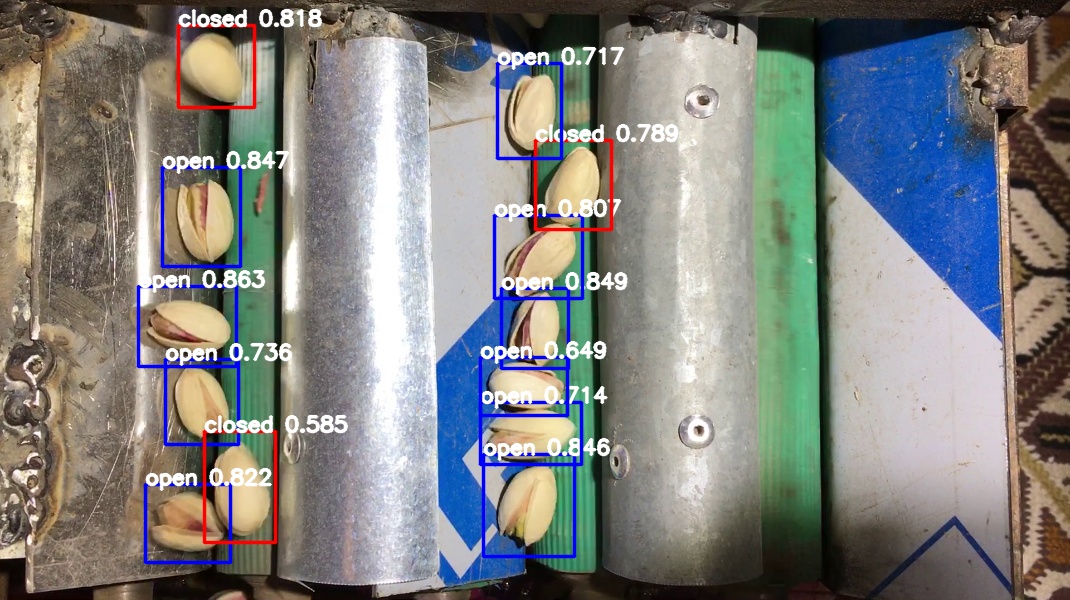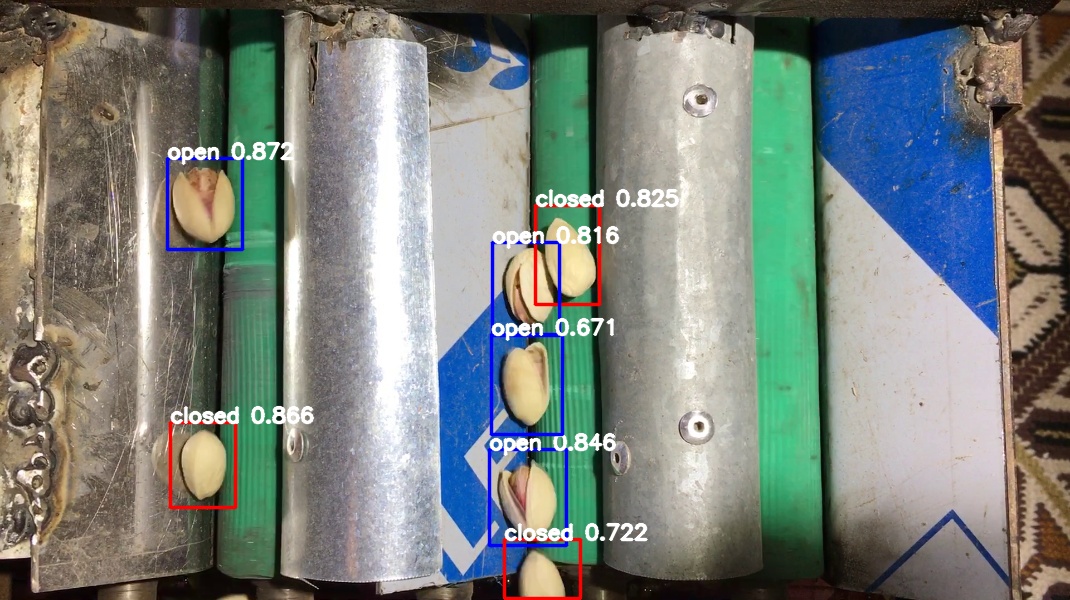Pistachios are nutritious nuts that are sorted based on the shape of their shell into two categories: Open-mouth and Closed-mouth. The open-mouth pistachios are higher in price, value, and demand than the closed-mouth pistachios. Because of these differences, it is considerable for production companies to precisely count the number of each kind. This paper aims to propose a new system for counting the different types of pistachios with computer vision. We have introduced and shared a new dataset of pistachios, including six videos with a total length of 167 seconds and 3927 labeled pistachios. Unlike many other works, our model counts pistachios in videos, not images. Counting objects in videos need assigning each object between the video frames so that each object be counted once. The main two challenges in our work are the existence of pistachios’ occlusion and deformation of pistachios in different frames because open-mouth pistachios that move and roll on the transportation line may appear as closed-mouth in some frames and open-mouth in other frames. Our novel model first is trained on the RetinaNet object detector network using our dataset to detect different types of pistachios in video frames. After gathering the detections, we apply them to a new counter algorithm based on a new tracker to assign pistachios in consecutive frames with high accuracy. Our model is able to assign pistachios that turn and change their appearance (e.g., open-mouth pistachios that look closed-mouth) to each other so does not count them incorrectly. Our algorithm performs very fast and achieves good counting results. The computed accuracy of our algorithm on six videos (9486 frames) is 94.75%.
The dataset (Pesteh-set) is available at https://www.kaggle.com/mohammadrahimzadeh/pistachios
source paper: arxiv.org/abs/2005.03990
Published paper: 10.1007/s42044-021-00090-6
The dataset is fully explained at https://github.com/mr7495/Pesteh-Set
Working Environment:
Tensorflow: 1.15
Keras: 2.1
The main purpose of our paper was to count the open-mouth and closed-mouth pistachios in videos. At the first stage, we have to generate the frames of the video and detect the pistachios in them with RetinaNet.
We have separated the dataset into five-folds and allocated 20 percent of the dataset for validation and the rest for the training. After the detection phase, we present the method we used for counting the open-mouth and closed-mouth pistachios. This counting algorithm runs very fast with good accuracy.

The General View of our proposed method for counting the pistachios
The images of the dataset were preprocessed and then resized to 1070×600 pixels.
We trained and validated RetinaNet on 3 different backbones: ResNet50, ResNet152, and VGG16. Transfer learning from the ImageNet pre-trained weights was utilized at the beginning of the training to speed up the network convergence. We also used data augmentation methods to improve the learning efficiency and stop the network from overfitting. The details of each fold are present is the next table.
| Fold | Training Images | Validation Images | Open-mouth Pistachios in Training Set | Closed-mouth Pistachios in Training Set | Open-mouth Pistachios in Validation Set | Closed-mouth Pistachios in Validation Set |
|---|---|---|---|---|---|---|
| Fold1 | 339 | 84 | 1600 | 1550 | 393 | 384 |
| Fold2 | 339 | 84 | 1610 | 1572 | 383 | 362 |
| Fold3 | 339 | 84 | 1553 | 1506 | 440 | 428 |
| Fold4 | 339 | 84 | 1641 | 1575 | 352 | 359 |
| Fold5 | 336 | 87 | 1568 | 1533 | 425 | 401 |
The code for training and evaluating the netwroks is availabe on Pistachio_RetinaNet_Training_&_Evaluating
All the CSV annotation files(train & test) in each fold along all the images are shared in the pesteh_set folder in this repository.
Some of the detected images are shown in the next figures.
The open-mouth and the closed-mouth pistachios could look like each other in many cases like the next figure, and it would be hard to distinguish them even with human eyes. This may be the reason; the made results are not very high.

Some of the hard examples in Pesteh-Set
This Table shows the average results of RetinaNet between five folds:
| Backbone Network | Recall | F1 score | map |
|---|---|---|---|
| ResNet50 | 93.44 | 92.05 | 91.87 |
| ResNet152 | 93.36 | 91.99 | 91.69 |
| VGG16 | 92.79 | 90.86 | 91.23 |
All the trained networks in each fold can be used by this link:
https://drive.google.com/open?id=1sc31RQK1tiA7gsgVL0PvudmBrOBn3USi
The Videos of Pesteh-Set is shared on Google Drive and Mendeley:
https://drive.google.com/drive/folders/1ojq1maRM82o3Ee4cOUelNFKqTXda_ovs?usp=sharing
https://data.mendeley.com/datasets/45hs5ht6k3/4
Also, the whole dataset can be downloaded at https://www.kaggle.com/mohammadrahimzadeh/pistachios
The second and main phase of our work was counting the number of open-mouth and closed-mouth pistachios in the videos. To do so, first, we used a frame generator to extract the frames of the video, then we fed the frames to the object detector, and finally, we had a list of bounding boxes for each frame.
There were several challenges in this phase. The first challenge was that we wanted to develop a method that could be performed very fast on the CPU. Some of the other ideas may need a GPU; otherwise, the process would become extremely time-consuming. However, our method works very much fast on CPU, even faster than the methods that need to be executed on GPU.
The second challenge was that some of the open-mouth pistachios could show themselves as closed-mouth pistachio in some consecutive frames and then reveal their open part only a few frames. Moreover, some open-mouth pistachios that are rolling on the transportation line could show their open part several times and then be appeared like closed-mouth pistachios like the next fig. We had to develop our algorithm somehow to prevent failing because of these challenges.
Another challenge is to develop the counting method in a way to prevent failure because of false detections or not-detected pistachios that may be affected by the pistachios occlusion.
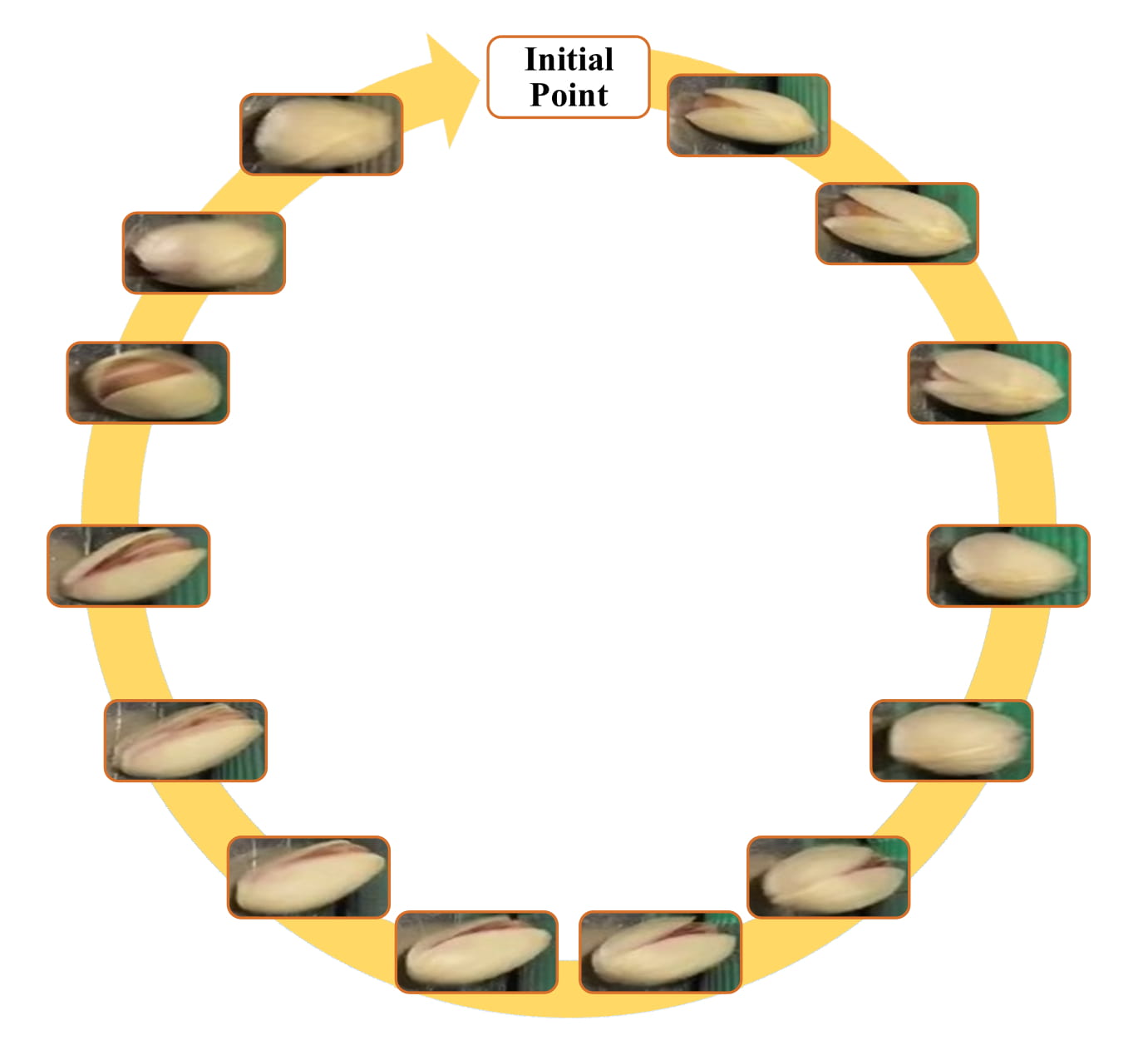
In this figure you can observe that a pistachio can be presented as open-mouth and closed-mouth
several times while moving.
The developed counter code is accessable in Counter.ipynb file in this repo. The Full details and explaination of the counter algorithm is presented in the paper
Here the obtained results of the counter algorithm for all the six videos are provided. It must be noticed that here are the results of the trained networks in fold1.
| Backbone Network | Ground-Truth Open-Mouth Pistachios | Ground-Truth Closed-Mouth Pistachios | Correctly Counted Open-Mouth Pistachios | Correctly Counted Closed-Mouth Pistachios | miscounted | Accuracy |
|---|---|---|---|---|---|---|
| ResNet50 | 409 | 152 | 397 | 145 | 11 | 94.75 |
| ResNet152 | 409 | 152 | 386 | 152 | 24 | 91.96 |
| VGG16 | 409 | 152 | 395 | 149 | 37 | 90.96 |
The paper is published as at:
https://arxiv.org/abs/2005.03990
https://doi.org/10.1007/s42044-021-00090-6
If you find our work useful, please cite it by:
@article{rahimzadeh2021detecting,
title={Detecting and counting pistachios based on deep learning},
author={Rahimzadeh, Mohammad and Attar, Abolfazl},
journal={Iran Journal of Computer Science},
pages={1--13},
year={2021},
publisher={Springer}
}
You can contact the developer by this email: mr7495@yahoo.com
